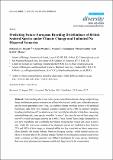Files in this item
Predicting future European breeding distributions of British seabird species under climate change and unlimited/no dispersal scenarios
Item metadata
| dc.contributor.author | Russell, Deborah Jill Fraser | |
| dc.contributor.author | Wanless, Sarah | |
| dc.contributor.author | Collingham, Yvonne C. | |
| dc.contributor.author | Huntley, Brian | |
| dc.contributor.author | Hamer, Keith C. | |
| dc.date.accessioned | 2015-11-03T15:40:06Z | |
| dc.date.available | 2015-11-03T15:40:06Z | |
| dc.date.issued | 2015-11-02 | |
| dc.identifier | 209437567 | |
| dc.identifier | 6e2a05dd-523b-436f-b3f5-5929b6d0363d | |
| dc.identifier | 84952908445 | |
| dc.identifier.citation | Russell , D J F , Wanless , S , Collingham , Y C , Huntley , B & Hamer , K C 2015 , ' Predicting future European breeding distributions of British seabird species under climate change and unlimited/no dispersal scenarios ' , Diversity , vol. 7 , no. 4 , pp. 342-359 . https://doi.org/10.3390/d7040342 | en |
| dc.identifier.issn | 1424-2818 | |
| dc.identifier.other | ORCID: /0000-0002-1969-102X/work/49052054 | |
| dc.identifier.uri | https://hdl.handle.net/10023/7735 | |
| dc.description | We thank the European Bird Census Council for their data on European seabird distributions. DJFR was supported by NERC UKPopNet. | en |
| dc.description.abstract | Understanding which traits make species vulnerable to climatic change and predicting future distributions permits conservation efforts to be focused on the most vulnerable species and the most appropriate sites. Here, we combine climate envelope models with predicted bioclimatic data from two emission scenarios leading up to 2100, to predict European breeding distributions of 23 seabird species that currently breed in the British Isles. Assuming unlimited dispersal, some species would be “winners” (increase the size of their range), but over 65% would lose range, some by up to 80%. These “losers” have a high vulnerability to low prey availability, and a northerly distribution meaning they would lack space to move into. Under the worst-case scenario of no dispersal, species are predicted to lose between 25% and 100% of their range, so dispersal ability is a key constraint on future range sizes. More globally, the results indicate, based on foraging ecology, which seabird species are likely to be most affected by climatic change. Neither of the emissions scenarios used in this study is extreme, yet they generate very different predictions for some species, illustrating that even small decreases in emissions could yield large benefits for conservation. | |
| dc.format.extent | 711221 | |
| dc.language.iso | eng | |
| dc.relation.ispartof | Diversity | en |
| dc.rights | © 2015 by the authors; licensee MDPI, Basel, Switzerland. This article is an open access article distributed under the terms and conditions of the Creative Commons Attribution license (http://creativecommons.org/licenses/by/4.0/). | en |
| dc.subject | Climate envelope modelling | en |
| dc.subject | Climate response surface | en |
| dc.subject | Conservation | en |
| dc.subject | Ecological niche modelling | en |
| dc.subject | Extinction risk | en |
| dc.subject | Foraging ecology | en |
| dc.subject | Global warming | en |
| dc.subject | Marine spatial planning | en |
| dc.subject | Sea surface temperature | en |
| dc.subject | Species distribution model | en |
| dc.subject | QH301 Biology | en |
| dc.subject | SDG 13 - Climate Action | en |
| dc.subject | SDG 14 - Life Below Water | en |
| dc.subject.lcc | QH301 | en |
| dc.title | Predicting future European breeding distributions of British seabird species under climate change and unlimited/no dispersal scenarios | en |
| dc.type | Journal article | en |
| dc.contributor.sponsor | NERC | en |
| dc.contributor.institution | University of St Andrews.School of Biology | en |
| dc.contributor.institution | University of St Andrews.Marine Alliance for Science & Technology Scotland | en |
| dc.contributor.institution | University of St Andrews.Scottish Oceans Institute | en |
| dc.contributor.institution | University of St Andrews.Centre for Research into Ecological & Environmental Modelling | en |
| dc.contributor.institution | University of St Andrews.Sea Mammal Research Unit | en |
| dc.identifier.doi | 10.3390/d7040342 | |
| dc.description.status | Peer reviewed | en |
| dc.identifier.grantnumber | Agreement R8-H12-86 | en |
This item appears in the following Collection(s)
Items in the St Andrews Research Repository are protected by copyright, with all rights reserved, unless otherwise indicated.

